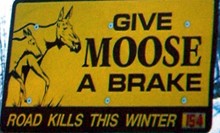Local Man's Work on Moose-Human Conflicts to Be Discovery Channel Feature
By 250 News
Sunday, October 25, 2009 03:57 AM

Roy Rea talks with Discovery Channel camera man Ryan Doyle
Prince George, B.C. – The work of a Senior Lab Instructor with UNBC's Ecosystem Science and Management Program, has resulted in his research being used in a feature for Discovery Channel.
Roy Rea has been working on trying to reduce the number of moose-vehicle collisions in northern B.C. His research , which had truckers inputting a GPS system each time they either spotted a moose or the carcass of a moose on the highway.
The data was broken down to highlight areas where at least 6 moose per kilometre were spotted over a five year period. The results boiled down to 29 hot spots on highways 16 and 97. Oddly enough, where the hot spots were identified, the appropriate signage to warn drivers about the possible presence of a moose, was either not there, or not appropriate. “It makes no sense to post a sign saying there are moose for the next 95 kilometres” says Rea, “A driver is only likely to heed the sign for about 3 kilometres and has totally forgotten about that sign by the time they reach kilometre 90.” He says signs need to be closer to the actual areas where moose are most likely to be.
Rea also says many of the signs have been in the same locations for dozens of years, and the moose migration patterns have changed because of changes to the forest, so the warning signs are no longer applicable.
“We looked at all the hot spots and there are some common points”:
1. 91% of the “hot spots” have no proper signage
2. Many of the hot spots are near a roadside mineral lick
3. There is typically, brush cover near the hot spot providing good browsing for moose
4. Many hot spots are near black spruce bogs
5. Most are NOT near a straight stretch of roadway where drivers have improved visibility.
Some of the efforts underway to reduce moose-vehicle impacts include excavating the mineral licks and filling them with rock. Rea says although fencing the areas off is the most effective change, installing fencing along the highways in northern B.C. is too costly. “We have to think outside the fencing ‘box’ it’s just too expensive. Animal overpasses ( such as those in Banff National Park) cost between $4 and $5 million each, and those reflective strips on posts along the highway simply don’t work .” Reducing speed is part of the solution says Rea, but he says even at 80 km/hr, a night driver doesn’t have enough stopping time if a moose should come out on to the highway. These are massive beasts, and typically, a vehicle hit the animals legs, then the entire 1200 pound animal is coming through the windshield. Every year, three people in B.C. die, or are seriously injured in such crashes.” 

In addition to reduced speed, Rea calls for effective brush cutting along the roadside, as this not only gives the driver a better view, but reduces the likelihood of moose “browsing” along the roadside. He also says the time has come to look at changing the signage images, perhaps going to something like the sign at right, which is used in Alaska.
In one week this month, Rea came upon three moose-vehicle collisions on the Tyner Boulevard-University Way stretch near the University of Northern B.C. in Prince George. In three separate crashes, a bull moose and two calves were killed. In all three instances, he says excessive speed was a contributing factor.
The stats gathered by Rea's research team also indicate the most likely time for such a crash is the Prince George region is December and January between 4 p.m. and 11:00 p.m.
The Discovery Channel program will examine human-wildlife conflict as a result of development pushing into the wilderness. It is expected the program will be aired next April or May.
Previous Story - Next Story
Return to Home








